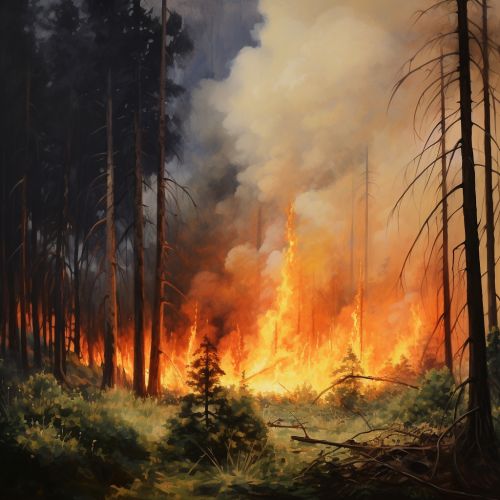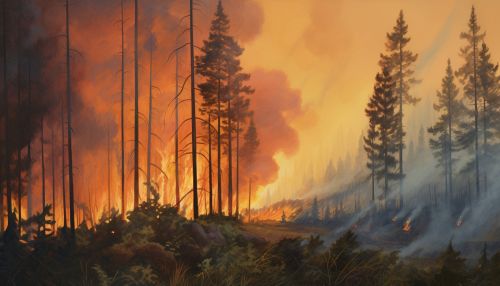Wildfire
Introduction
A wildfire, also known as a forest fire, vegetation fire, grass fire, peat fire, or bushfire, is an uncontrolled fire that rapidly spreads across vegetation and forest areas. Wildfires can occur in various ecosystems, including forests, grasslands, savannas, and other vegetated areas. They are a natural part of many ecosystems, helping to maintain biodiversity and promote growth. However, when they occur in close proximity to human habitation, they can cause extensive property damage and loss of life.
Causes
Wildfires can be ignited by natural causes or human activities. The most common natural cause is lightning, which can generate sparks capable of igniting dry vegetation. Volcanic activity can also lead to wildfires, as can spontaneous combustion caused by heat generated from the decomposition of organic material.
Human activities are a significant cause of wildfires. These can be intentional, such as land clearing and arson, or unintentional, such as discarded cigarettes, unattended campfires, and sparks from machinery. Climate change, brought about by human activity, is also increasing the frequency and intensity of wildfires.
Behavior and Spread
The behavior and spread of wildfires are influenced by weather conditions, topography, and the type and condition of vegetation. Wind speed and direction can significantly affect the rate and direction of fire spread. Topography influences fire behavior, with fires spreading more rapidly uphill due to the preheating of vegetation above the fire. The type and condition of vegetation, or fuel, also play a significant role. Dry, dead vegetation burns more easily and quickly than green, living vegetation.
Effects
Wildfires have both positive and negative effects on ecosystems. On the positive side, they can stimulate the growth and reproduction of certain plant species, promote biodiversity, and recycle nutrients back into the soil. On the negative side, they can lead to habitat loss, soil erosion, and the release of carbon dioxide into the atmosphere.
In terms of human impact, wildfires can cause property damage, loss of life, and economic hardship. They can also have significant health impacts, with smoke causing respiratory problems and exacerbating existing health conditions.
Prevention and Control
Preventing and controlling wildfires is a complex task that involves a combination of strategies. These include public education, regulation of activities that can cause fires, and the creation of firebreaks. Controlled burns, also known as prescribed burns, are also used to reduce the amount of available fuel.
Once a wildfire has started, it can be controlled through a combination of methods. These include direct attack, where firefighters attempt to extinguish the fire at its edge, and indirect attack, where firefighters create firebreaks or backfires to stop the fire's spread.
See Also


Conclusion
Wildfires are a powerful force of nature that can have devastating effects, particularly when they occur near populated areas. However, they also play a crucial role in many ecosystems, promoting biodiversity and nutrient cycling. Understanding the causes and behavior of wildfires, as well as effective prevention and control strategies, is essential for managing this complex natural phenomenon.
